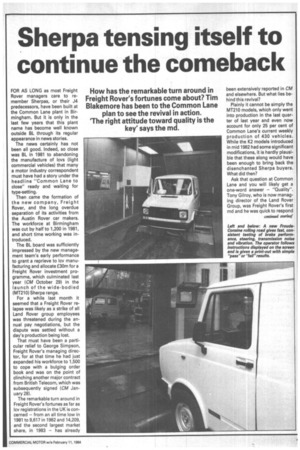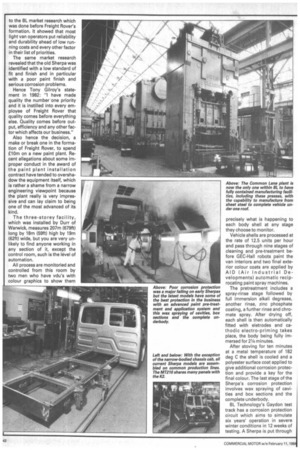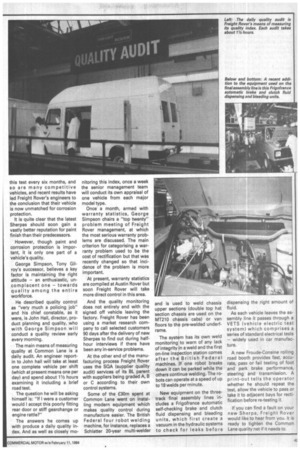Sherpa tensing itself to continue the comeback
Page 43

Page 44

Page 45

If you've noticed an error in this article please click here to report it so we can fix it.
How has the remarkable turn around in Freight Rover's fortunes come about? Tim Blakemore has been to the Common Lane plan to see the revival in action. 'The right attitude toward quality is the key' says the md.
FOR AS LONG as most Freight Rover managers care to remember Sherpas, or their J4 predecessors, have been built at the Common Lane plant in Birmingham. But it is only in the last few years that this plant name has become well known outside BL through its regular appearance in news stories.
The news certainly has not been all good. Indeed, so close was BL in 1981 to abandoning the manufacture of Icvs (light commercial vehicles) that many a motor industry correspondent must have had a story under the headline "Common Lane to close" ready and waiting for type-setting.
Then came the formation of the new company, Freight Rover, and the long overdue separation of its activities from the Austin Rover car makers. The workforce at Birmingham was cut by half to 1,200 in 1981, and short time working was introduced.
The BL board was sufficiently impressed by the new management team's early performance to grant a reprieve to Icy manufacturing and allocate £30m for a Freight Rover investment programme, which culminated last year (CM October 29) in the launch of the wide-bodied (MT210) Sherpa range.
For a while last month it seemed that a Freight Rover relapse was likely as a strike of all Land Rover group employees was threatened during the annual pay negotiations, but the dispute was settled without a day's production being lost.
That must have been a particular relief to George Simpson, Freight Rover's managing director, for at that time he had just expanded his workforce to 1,500 to cope with a bulging order book and was on the point of clinching another major contract from British Telecom, which was subsequently signed (CM January 28),
The remarkable turn around in Freight Rover's fortunes as far as Icy registrations in the UK is concerned — from an all time low in 1981 to 9,617 in 1982 and 14,209, and the second largest market share, in 1983 — has already been extensively reported in CM and elsewhere. But what lies behind this revival?
Plainly it cannot be simply the MT210 models, which only went into production in the last quarter of last year and even now account for only 25 per cent of Common Lane's current weekly production of 430 vehicles. While the K2 models introduced in mid 1982 had some significant modifications, it is hardly plausible that these along would have been enough to bring back the disenchanted Sherpa buyers. What did then?
Ask that question at Common Lane and you will likely get a one-word answer — "Quality". Tony Gilroy, who is now managing director of the Land Rover Group, was Freight Rover's first md and he was quick to respond to the BL market research which was done before Freight Rover's formation. It showed that most light van operators put reliability and durability ahead of low running costs and every other factor in their list of priorities.
The same market research revealed that the old Sherpa was identified with a low standard of fit and finish and in particular with a poor paint finish and serious corrosion problems.
Hence Tony Gilroy's statement in 1982: "I have made quality the number one priority and it is instilled into every employee of Freight Rover that quality comes before everything else. Quality comes before output, efficiency and any other factor which affects our business."
Also hence the decision, a make or break one in the formation of Freight Rover, to spend £10m on a new paint plant. Recent allegations about some improper conduct in the award of the paint plant installation contract have tended to overshadow the equipment itself, which is rather a shame from a narrow engineering viewpoint because the plant really is very impressive and can lay claim to being one of the most advanced of its kind.
The three-storey facility, which was installed by Durr of Warwick, measures 207m (679ft) long by 18m (59ft) high by 19m (62ft) wide, but you are very unlikely to find anyone working in any section of it, except the control room, such is the level of automation.
All process are monitoried and controlled from this room by two men who have vdu's with colour graphics to show them precisely what is happening to each body shell at any stage they choose to monitor.
Vehicle shells are processed at the rate of 12.5 units per hour and pass through nine stages of cleaning and pre-treatment before GEC-Hall robots paint the van interiors and two final exterior colour coats are applied by AID (Air Industrial Developments) automatic reciprocating paint spray machines.
The pretreatment includes a spray-rinse stage followed by full immersion alkali degrease, another rinse, zinc phosphate coating, a further rinse and chro mate spray. After drying off, each shell is then automatically fitted with eletrodes and ca thodic electro-priming takes place, the body being fully immersed for 21/4 minutes.
After stoving for ten minutes at a metal temperature of 182 deg C the shell is cooled and a polyester surface coat applied to give additional corrosion protec tion and provide a key for the final colour. The last stage of the Sherpa's corrosion protection involves wax spraying of cavities and box sections and the complete underbody.
BL Technology's Gaydon test track has a corrosion protection circuit which aims to simulate six years' operation in severe winter conditions in 12 weeks of testing. A Sherpa is put through this test every six months, and so are many competitive vehicles, and recent results have led Freight Rover's engineers to the conclusion that their vehicle is now unmatched for corrosion protection.
It is quite clear that the latest Sherpas should soon gain a vastly better reputation for paint finish than their predecessors.
However, though paint and corrosion protection is important, it is only one part of a vehicle's quality.
George Simpson, Tony Gilroy's successor, believes a key factor is maintaining the right attitude — an enthusiastic, uncomplacent one — towards quality among the entire workforce.
He described quality control as "very much a policing job" and his chief constable, as it were, is John Hall, director, product planning and quality, who with George Simpson will conduct a quality review early every morning.
The main means of measuring quality at Common Lane is a daily audit. An engineer reportin to John hall will take at least one complete vehicle per shift (which at present means one per day) and spend about 11/2 hours examining it including a brief road test.
The question he will be asking himself is: "If I were a customer would I accept this poorly fitting rear door or stiff gearchange or engine rattle?"
The answers he comes up with produce a daily quality index. And as well as closely mo
nitoring this index, once a week the senior management team will conduct its own appraisal of one vehicle from each major model type.
Once a month, armed with warranty statistics, George Simpson chairs a "top twenty" problem meeting of Freight Rover management, at which the most serious warranty problems are discussed. The main criterion for categorising a warranty problem used to be the cost of rectification but that was recently changed so that incidence of the problem is more important.
At present, warranty statistics are compiled at Austin Rover but soon Freight Rover will take more direct control in this area.
And the quality monitoring does not entirely end with the signed off vehicle leaving the factory. Freight Rover has been using a market research company to call selected customers 90 days after the delivery of new Sherpas to find out during halfhour interviews if there have been any in-service problems.
At the other end of the manufacturing process Freight Rover uses the SQA (supplier quality audit) services of its BL parent with suppliers being graded A, B or C according to their own control systems.
Some of the £30m spent at Common Lane went on installing modern equipment which makes quality control during manufacture easier. The British Federal four robot welding machine, for instance, replaces a Schlatter 20-year multi-welder and is used to weld chassis upper sections (double top hat section chassis are used on the MT210 chassis cabs) or van floors to the pre-welded underframe.
The system has its own weld monitoring to warn of any lack of integrity in a weld and the first on-line inspection station comes after the British Federal machines. If one robot breaks down it can be parked while the others continue welding. The robots can operate at a speed of up to 18 welds per minute.
New equipment on the threetrack final assembly lines includes a Frigofrance automatic self-checking brake and clutch fluid dispensing and bleeding units, which first create a vacuum in the hydraulic systems to check for leaks before dispensing the right amount of fluid.
As each vehicle leaves the assembly line it passes through a VETS (vehicle electric test system) which comprises a series of standard electrical tests — widely used in car manufacture.
A new Froude-Consine rolling road booth provides fast, accurate, pass or fail testing of foot and park brake performance, steering and transmission. A print-out tells the operator whether he should repeat the test, allow the vehicle to pass or take it to adjacent bays for rectification before re-testing it.
If you can find a fault on your new Sherpa, Freight Rover would like to hear from you. It is ready to tighten the Common Lane quality net if it needs to.
















































































